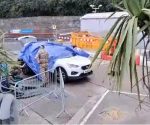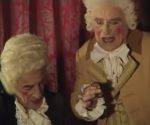UK Government doubles down on Salisbury; Part Two: the problem of Rowley’s perfume not being the same as the Met Police’s
In a statement by the Metropolitan Police, put out on 5th September, regarding the charging of supposed Russian nationals, Alexander Petrov and Ruslan Boshirov, in connection with the “Skripal poisoning”, it was made very clear that the indictment did not relate to the ancillary case in the affair: to wit, the circumstances by which Salisbury area residents, Charlie Rowley and Dawn Sturgess, came to become ill. However, the Met Police did claim the primary and secondary cases are linked:
We have now linked the attack on the Skripals and the events in Amesbury which affected Dawn Sturgess and Charlie Rowley. It now forms one investigation. We do not believe Dawn and Charlie were deliberately targeted, but became victims as a result of the recklessness in which such a toxic nerve agent was disposed of. We know that Novichok was applied to the Skripals’ front door in an area that is accessible to the public, which also endangered the lives of members of the public and emergency service responders.
The exact manner by which police have drawn the two cases together is a matter to be returned to very shortly. First, however, there will be an brief explanation of other contents of the statement that pertain to Charlie Rowley and Dawn Sturgess, and before that, a recap of a framework, developed previously at FBEL, for distinguishing the differences between what the British Government, the Met Police, and Charlie Rowley all say about how the accidental poisonings occurred. This organisation of thought remains relevant according to the police statement.
Thus far in their investigation – and it’s a position that is retained with the issuing on the 5th September statement – the police have claimed that a bottle found on 11th July, at what they call Charlie Rowley’s “home address” in Muggleton Road (FBEL contends even this basic so-called fact), contained the material that poisoned Charlie Rowley and Dawn Sturgess. Even as late as 24th July, at the time of an interview with ITV, Charlie Rowley appeared to maintain that he did not know where he found a bottle of perfume that corporate-media (thus Government) had claimed was the poisoning material. In previous FBEL pieces, this perfume bottle has been labelled the “discarded object”, or more pertinently, Charlie Rowley’s “found object”. The reader should appreciate, then, that there has for a long time been a dislocation of facts. The poisoning material found by police could not be linked with the “found object” because how the latter came to be in Rowley’s possession could not be accounted for.
Rowley evidently gave his first indication of where he might have discovered the “found object” during a follow-up ITV news interview (26th July). Taking part in a piece of filming designed to create definite ideas in the minds of the audience, Rowley was brought to a place in Salisbury by Rupert Evelyn (the ITV “journalist” previously detailed to present Rowley’s story), to talk about his recollections. A written accompaniment was published by ITV, and contained the following extract:
It’s the burning question that so far remains unanswered.
The police do not know where the deadly bottle of Novichok was found and Charlie Rowley cannot remember…
“It’s a possibility that I may have found it here.” he tells us at some bins outside the back of some shops in the centre, but he says “I don’t know, all I can say is a vague description of an area and this being one of them”
…Charlie says he’s shared this same information with the police and he’s keen to help the investigation.”
Fascinatingly, the Met Police’s statement takes on schizophrenic characteristics in its handling of the “found object”. In a very significant turn of phrasing, all the information that police want the public to understand as coming from Rowley is expressed in a paragraph that starts “Charlie told police…”, as can be seen below:
Officers have interviewed Charlie a number of times about his recollections prior to falling ill.
Charlie told police he found a box he thought contained perfume in a charity bin on Wednesday, 27 June. Inside the box was a bottle and applicator. He tried to put the two parts together at his home address on Saturday, 30 June, and in doing so got some of the contents on himself. He said Dawn had applied some of the substance to her wrists before feeling unwell.
After Charlie told police where he found the box, cordons were put in place and two bins behind shops in Catherine Street, Salisbury, were removed.
Please notice that while Charlie Rowley remained apprehensive about the veracity of his information in his conduct with ITV, the police portray him as being certain in their dealings with him. And yet, the police also expressly stipulated that their investigation lacked the information that could account for where Rowley obtained the “found object”:
We don’t yet know where the suspects [Alexander Petrov and Ruslan Boshirov] disposed of the Novichok they used to attack the door, where Dawn and Charlie got the bottle that poisoned them, or if it is the same bottle used in both poisonings.
The Met Police appear to be saying that they still cannot link the poisoning material that they discovered in a search of an address in Muggleton Road with the “found object” that they report as being salvaged from a waste skip by Charlie Rowley.
However, in their statement, the Met Police do claim to be able to connect their poisoning material with the substance that is claimed to have been applied to the door handle on the front door of Sergei Skripal’s place of residence. Four pieces of rationale are offered for making the connection (the fourth doesn’t make any sense), but the principal one is this:
Our own analysis, and the Organisation for the Prohibition of Chemical Weapons in the Hague, has confirmed that the same type of Novichok was used in both cases.
In fact, realistically, there being any link entirely depends on OPCW findings, because potentially they are going to be independent of the Met Police and UK Government and any agenda it may have. An August 7th article appearing in The Independent provides an idea of how close in proximity the OPCW were allowed to the sources of their samples:
The British government invited the OPCW to assist the investigation into the Amesbury incident early last month, when The Independent understands they were given access to the bottle of novichok found at Mr Rowley’s home and samples from the victims…
Investigators are expected to arrive in Britain over the coming week, when The Independent understands they will take “environmental samples” and visit Mr Rowley’s home for the first time.
A first visit to Rowley’s “home” in August 2018 might be leaving it a little too late, and really only any good for the sake of appearances (as far as the UK Government is concerned). Evidently, the key data – meaning the police’s poisoning material, and samples from the victims apparently already collected – was supplied to the OPCW for testing, and was not obtained by that organisation directly. It shouldn’t need to be explained that if the British Government prepared the data by which the OPCW would come to its conclusions, then those conclusions are open to manipulation by the British Government. (Even if the OPCW did take its own samples directly, and they did indeed match, then it doesn’t prove who put the material in the environment to be found).
To recap, the Met Police claimed “[confirmation] that the same type of Novichok was used in both cases” – meaning in the attack on the Skripals, and in the accidental poisoning of Rowley and Sturgess. Furthermore, the Met Police has stated that, regarding their poisoning material, “tests undertaken at DSTL (Defence Science and Technology Laboratory) established the bottle contained a significant amount of Novichok”, and that “[Sturgess] fell ill… after being exposed to Novichok and she never regained consciousness… Her partner, Charlie Rowley, was also exposed to the nerve agent”.
So the impression is therefore formed that Novichok provides a connection between the attack on the Skripals, and the poisoning material found in Rowley’s “home”, and then that material and the illnesses of Rowley and Sturgess. But here’s the crucial fact of the matter: these connections depend entirely on the integrity of the OPCW investigation [and, indeed, any (mis)representation of the findings – see the contribution by commenter Isa below]. If it was made flawed by British Government manipulation, then the connections are not safe to make. And if we come at this from another angle, we can demonstrate evidence that undermines what is effectively the only method by which the Met Police have been able to link their poisoned material found at Muggleton Road, and Rowley’s “found object”.
There is enough information in the public domain to deduce that Charlie Rowley’s “found object” is not the Met Police’s poisoning material. In the first example of this, a picture of a perfume box released by the Met Police is not of the same dimensions of one described by Charlie Rowley in his ITV interview. Police say that the poisoning material was in a perfume bottle, and a box related to the bottle was also found at the “home” of Charlie Rowley. In the image issued by the Met Police, the box has dimensions of 5 to 6 cm in width (this edge is not laid flat in order that it might more accurately be measured), 9 cm high, and 1½ cm thick. That’s about 2 to 2⅓ inches wide, 3½ inches high, and just over half an inch thick. Rowley gave the dimensions thusly (recorded originally in the FBEL article mentioned below):
It was 3 by 3 inch box, half inch thick which contained a glass bottle so you had to remove the bottle from the Cellophane wrapper, put the pump dispenser on the bottle and I ended up tipping some on my hands but I washed it off under the tap.
The second discrepancy arises from the appearance of the “pump dispenser” as shown in an image of a perfume bottle released by the Met Police, and said to be the container of the poisoning material. The head of the pump dispenser system appears to be a white cap out of which extends a long-barrelled tube. This nozzle has one hole running through it; obviously this is the route by which a substance is expelled from the vessel. The item in question looks like the sort of thing that should be used to apply a flowing viscous liquid, such as soap. It is not a dispenser of the sort that disperses liquid in the form of a vaporous cloud (the word we’re looking for might be “atomiser”). However, we are told that Sturgess sprayed herself with the perfume. We deduced, here at FBEL, that Sturgess did not appear to be under any impression that the liquid in the bottle was anything other than perfume. Remember that Charlie Rowley told ITV that the bottle “looked expensive”. The bottle that the Met Police have produced looks anything but pricey.
The next problem stems from Rowley’s descriptive narrative in the extract above, and has also been raised previously at FBEL. It is highly unlikely that a dispensing system for a nerve agent would require construction in a manner that would put its assembler at risk of being exposed to the dangerous substance within the vessel. And it is here that we arrive into some very significant territory for deducing that one thing is definitely not the same as another. When the police consider the vessel containing their poisoning material, and come to a conclusion that they do not know if it was not used previously by a Russian assassination team, then they are certainly discussing an object that is not Charlie Rowley’s found object. Charlie Rowley’s perfume bottle was enclosed in sealed cellophane – there’s a major clue. Charlie Rowley had to attach the applicator onto the bottle – why on earth would an assassin have disassembled the system after it had been used? He wouldn’t, because of the risk of touching the dispenser nozzle where it had exuded nerve agent.
Now consider this extract from the Met Police’s 5th September statement:
Previously, during a search of Charlie’s home address in Muggleton Road on 10 July a small box labelled as Nina Ricci Premier Jour was recovered from a rubbish bag in the kitchen. On 11 July a small glass bottle with a modified nozzle was found on a kitchen worktop. Tests undertaken at DSTL established the bottle contained a significant amount of Novichok.
As has been pointed out before at FBEL, Charlie Rowley never, at any time, directed the police to find their poisoning material at Muggleton Road by any information that he imparted to them, and this is confirmed by omission in the police statement which does not tell of any assistance from Rowley in their search. Rowley did not give police information whereby his “found object” could be identified as the police’s poisoning material, and the two have only been conflated after the fact. Please notice in the above extract that it appears that in two days (that we know about) when police were searching the kitchen in Muggleton Road, the poisoning material was not discovered for the entirety of the first day – despite it being in an obvious position.
The author stands by an assessment arrived at in previous articles published at this site, principally Rowley’s found object and the Met’s poisoning material – and never the twain shall meet (here), where it was written
Charlie’s discarded object [“found object”] appears as if it could be a completely harmless perfume bottle that certainly didn’t hurt him when he became exposed to its contents. If there is no account for how one thing could be the other [i.e. how the Met Police’s poisoning material could be the “found object”], then there is no fact of one thing being the other. And if the discarded object [“found object”] does not account for the presence of the poisoning material, then the latter must have turned up by itself. How did it do that? Certain people who wanted it found put it there. Or, the people searching for it put it there. Or, the people searching for it invented the idea that they had found it.
The author maintains that Rowley was not made ill through any of his own activities, or any possession he might have collected in the way of pursuing them, and neither was he was aware of a poisoning material at Muggleton Road. And another quote from the abovementioned FBEL article explains why, despite his ignorance, he came to have knowledge about the cause of his illness:
[Rowley only] supposes he knows something of the history of the object he had in his possession, and which he supposes he poisoned himself with. It doesn’t follow that he found the object… We know all too well by now that he doesn’t know how the object came to be in his possession. Any history that Rowley is aware of that links his found object – the perfume – with the “bottle of Novichok” could just as well have been supplied by the same people who told him that he’d been poisoned.”
As mentioned at the top of this, charges have not been brought against the Russians for the murder of Sturgess – don’t forget, dear reader, that the police have already created expectations by declaring Sturgess a victim of murder, and so we shouldn’t be surprised to see the likes of this from the Times:
The families of two novichok victims have spoken of their anger and frustration at police being unable to charge two Russian suspects with the poisoning of Charlie Rowley and death of Dawn Sturgess
However, as has previously (and more than once) been pointed out at FBEL:
In order to establish that a murder [of Dawn Sturgess] has taken place, police need to link this [poisoning] material to a discarded object [Rowley’s “found object”] which then needs to be linked to the attempted murder of the Skripals.
Don’t be surprised if charges are never made in relation to Sturgess and Rowley. [Indeed, a commenter on this article (see below) helpfully writes to indicate that in fact the OPCW cannot draw what would be the required chemical connection between the Rowley/Sturgess and Skripal cases].
[This is the second part of a series, the first of which is here].



















The OPCW report and out the day before the met came out with the images of the two ” Russians “. The report states that it CAN NOT state that the substances used in Salisbury and Amesbury are from same batch .
12. Due to the unknown storage conditions of the small bottle found in the house of Mr Rowley and the fact that the environmental samples analysed in relation to the poisoning of Sergei and Yulia Skripal and Mr Nicholas Bailey were exposed to the environment and moisture, the impurity profiles of the samples available to the OPCW do not make it possible to draw conclusions as to whether the samples are from the same synthesis batch.”
https://www.opcw.org/fileadmin/OPCW/S_series/2018/en/s-1671-2018_e_.pdf